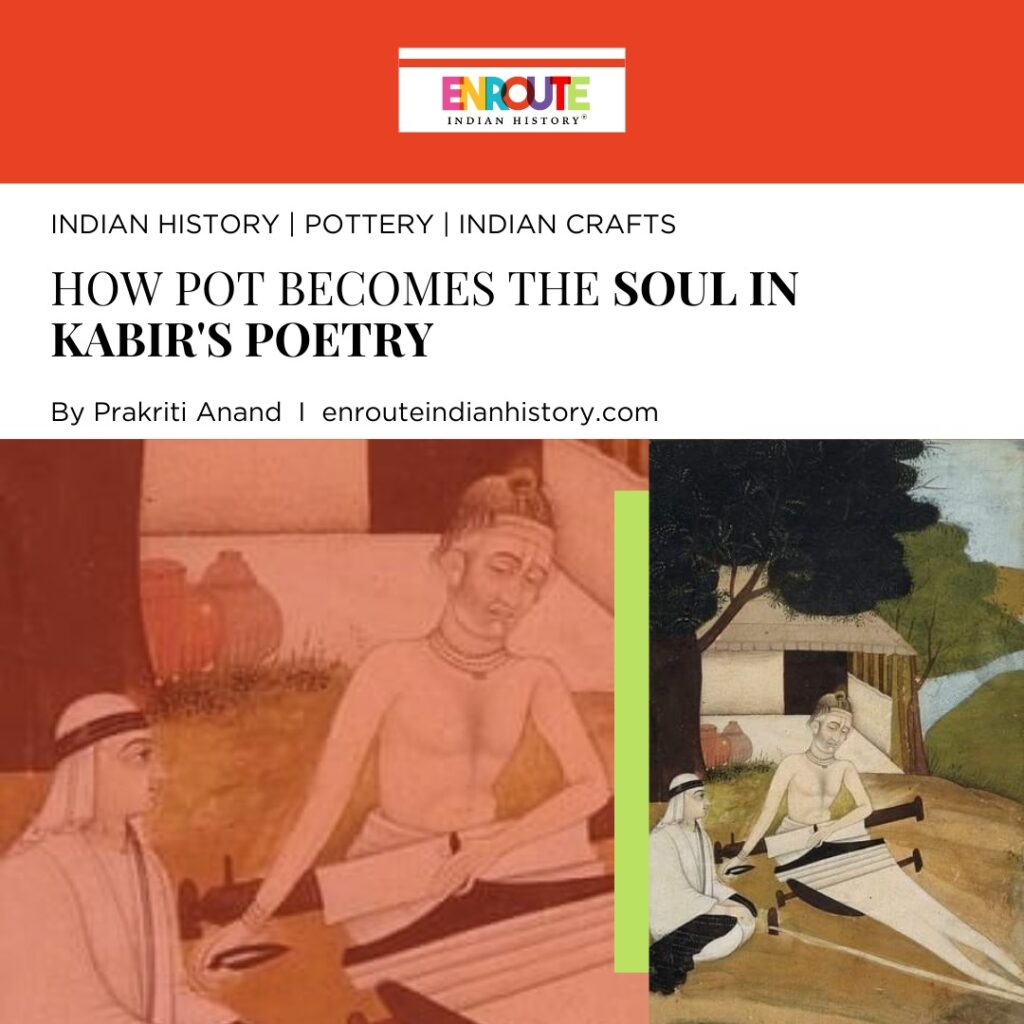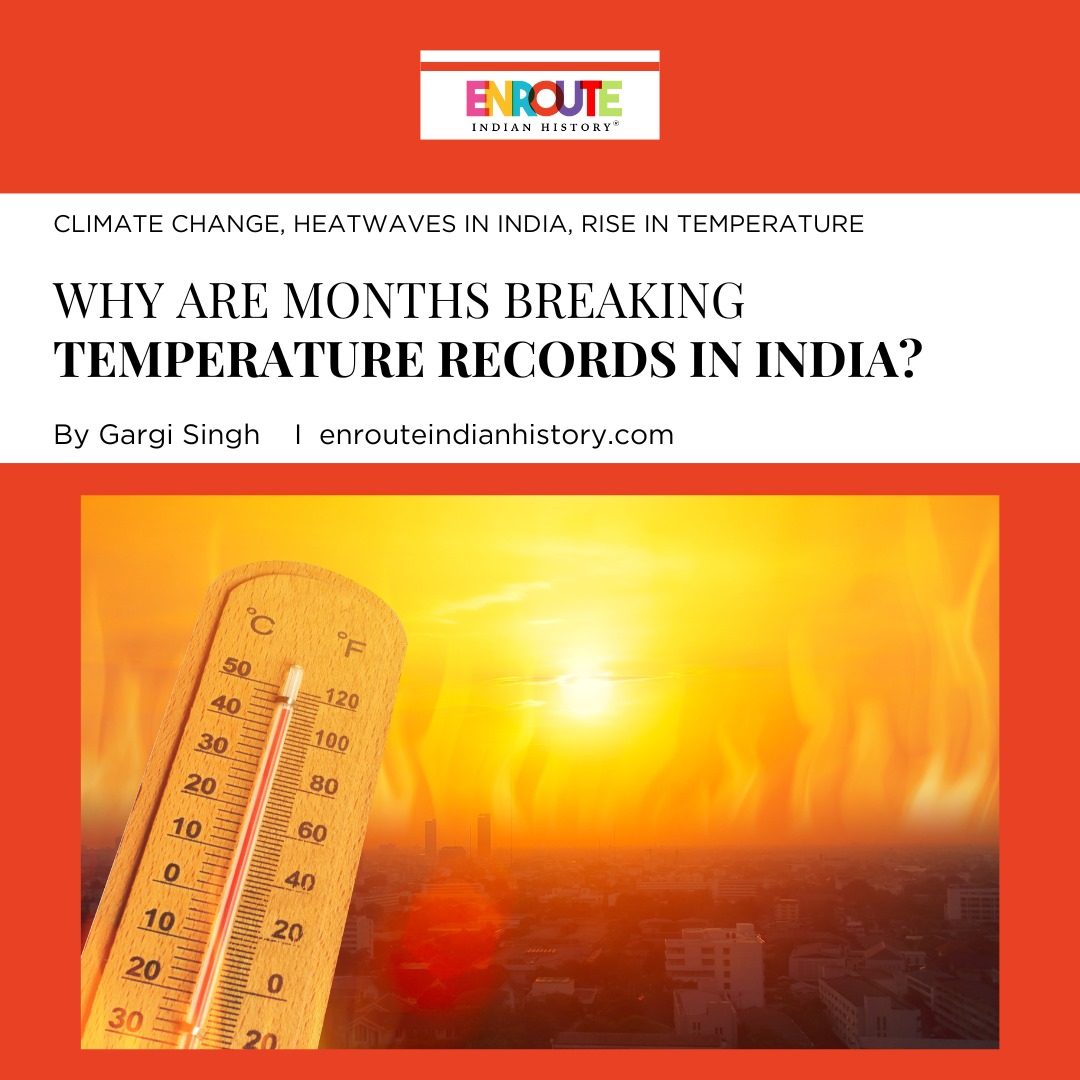

Potter Making a Pot
[Source- https://biblicalisraeltours.
Pots and pottery in Indian tradition have been one of the first proofs of civilization. From the worship of Earth as mother to pots becoming an integral part of the traditional Indian household, the presence of earthenware in the culture is as old as time. Potters or Kumhars draw ancestry to Prajapati who is related to the supreme creator (Subrahmanian 2018). In the folk tradition, the most delicate descriptions of pot in the context of the Lilas of Krishna and the maidens or Gopis of Brija are immortalized in Indian culture. In the ritual space of antyeshti or the post-death rituals, the act of circumambulating the pyre with a water-filled pot which is at the end broken, serves as a reminder of life and its impermanence. In this long tradition intertwining the pot and human body and life come the tales of Sohni Mahiwal in the rural and folk culture of the Indian subcontinent and the writings of the popular saint Kabir on pot or Kumbha/ghada (Indian terms for the earthen vessel) as a symbol and lens through which he sees human body, teacher-student or Guru-shishya relationship and death. Originating at different points in the stream of time and belonging to different geographical contexts, these stories are brought together by a common presence of the commonplace earthen pot.
Sohni-Mahiwal: An Eternal Lore of Romance
Traveling from Bukhara, a wealthy trader by the name of Izzat Beg (Mahiwal) settles on the banks of Chenab. His eyes fall on a beautiful woman, named Sohni (“she who is beautiful”), selling pots in the market, and it was love at first sight! But alas the fate of the young lovers was not a happy one. Sohni was married to another man in her caste, a pained Mahiwal remained at the banks of Chenab, close to the Mitti (land) on which his Sohni lived. Finding solace in the fact that his beloved was on the other side of the same stream, Sohni who could not swim, used to take earthen pots every night and floated with them to meet Mahiwal. Fate once again turned against the lovers, as overhearing the plan of Sohni, her sister-in-law switched the usual baked pot with an unbaked one. As Sohni reached the middle of a flooding Chenab, the mud withered away, leaving her stranded with the hope of crossing over. Seeing his beloved’s life in danger, Mahiwal jumped into the river, meeting and embracing Sohni as the waves of Chenab swallowed the lovers (Dhillon 2014).
Beginning as a qissa or oral folklore in the areas around Chenab, now located in India and Pakistan, the story of Sohni-Mahiwal was in circulation for a long time, before it was penned down, and put in written words. One of the first mentions of the lovers comes from the 17th-century work of Punjabi poet Bhai Gurudas, but till then the story had already lived many lives through the multiple retellings in popular culture. Qadir Yar and Abdul Latif Bhatti infused the romantic tale with Sufi colors, giving it a deeper hue and meaning. On the Mazar or tomb of Mai Sohni in Shahadpur Sindh, excerpts of Bhatti’s “Sur Sohni” written in Sindhi commemorate the undying tale of Sohni-Mahiwal. In the modern mediums, movies bearing the title “Sohni-Mahiwal” have been made by the film industries of India and Pakistan from the pre-Independence era, bringing the writings of the medieval Sufis to the silver screen (Nawathe 1958). The most recent example of the eternal resonance of the tale is the popular Coke studio song- “Par Channa De,” a beautiful recreation of the conversation of Sohni with the earthen pot, the Ghada, on which she had placed all her hopes.
The Earthen Pot as Murshid or Teacher
The song begins with an evocative line- “Paar Channa de disse kulli yaar di (Noori 2016)” (I see the hut of my beloved beyond the Chenab River), “Ghadeya, ghadeya aave ghadeya” (Let us keep going forth, O Earthen Pot), “Raat Haneri Nadi thatha maar di” (The night is dark, and the river flooding), “adiye adiye aani adiye” (O woman, do not be too persistent). In the middle of the journey, the unbaked pot begins to melt away, and Sohni realizes her mistake. She had chosen an unworthy medium. “Kacheya te rakhiye na ummed paar di” (do not place your hopes of crossing the river on an incapable one) are the lines of the next stanza, representing the realization of Sohni, which came too late. Comparing Sohni, the eager lover with a soul eager to reach the divine, Sufi traditions, see the unbaked Ghada as an incompetent teacher or Murshid. The romantic tale becomes a tale of profound wisdom and caution to the new Murid or student seeking a Master’s. If one chooses an unworthy master, he is going to lead one to the middle of the storming river of life and leave them in Majhadar or “the middle”, unsuccessful in attaining the supreme goal. The memorable Coke Studio song, following the Sufi inspirations, ends on a cautionary note- “Phada Pallara Pakke Murshid Da, Jeda Tennu Paar Lagave” – “Hold tightly to the Pakka (a term used for baked or cooked and True) Master, who takes you to the end of your journey.”
 Sohni-Mahiwal, oil on canvas by Sobha Singh (Source-Pinterest)
Sohni-Mahiwal, oil on canvas by Sobha Singh (Source-Pinterest)
For many, the dissolving of the earthen pot in the waves of Chenab symbolizes the impermanence of the human body and a high point of Fanna or self-immersion to the degree of the destruction of the idea of “self”. With her mortal form represented by the Ghada or pot destroyed, Sohni meets Mahiwal in the Chenab River, forever uniting with his soul.
Kabir, the Potter and the Pot
Hailed beyond the boundaries of religion, caste, and culture (Aggarwal 2021), Kabir, the medieval mystic poet embodies the quality of earth or mud (mitti)- ever-transforming, everyone’s and simultaneously no one’s. Drawing inspiration from his humble environs, one of the things that Kabir observed abundantly and featured in his writings is the earthen pot in making (Abdi 2024).

Seeing the potter at work, handling the unbaked pot with a balance of care and sternness, Kabir writes- “Guru kumhar, Shish Kumbha hai, gadha gadha kaadhe khot” (the guru or teacher is Kumhar or potter and the student is the earthen pot, whose faults are slowly worked upon by the potter), “Bheetar haath sahaar de, baahar baahe chot” (the master or the potter supports the student or pot from within, while using force from the outside). The duality of a perfect master’s gentleness and strictness is what creates the perfect student, a message beautifully and simply put in words by the only one who can, Kabir.
Showcasing brilliance in his words, wisdom, and an in-depth understanding of the ancient philosophies, Kabir sees the ever-changing Mitti or Maati (a term frequently used by him for mud or earth) as a constant element, which births, sustains, and embraces the human life at its end. Seeing the mundane task of the potter kneading the mud with his feet, Kabir taunts the proud human through words exchanged between the mud and the potter. He writes- “Maati Kahe Kumhar se, Tu kya raundhe mohe, Ek din aisa aayega, Mai raundhongi tohe” (the mud tells the potter, today is your day, so you knead me and place me under your feet, but a day will come (when you die), that I will be burying you).
The earthen pot is a recurring motif in the Doha and Saakhis of Kabir. A riveting moment of spiritual realization is achieved by the audience of Kabir when one listens to the moving lines- “Bhala Hua Mori Gagari Phooti, Main Paniya Bharan Se Chooti, More Sar Se Tali Bala” (Thank God that my pot is broken now, I am freed from the tedious task of filling water, the weight has been lifted from my head). The earthen pot in this context is the human body, impermanent and prone to be destroyed after a point. The true devotee according to Kabir, who has attained inner wisdom is aware of the useless weight of the human body and life. For them, death or the end of attachment to the destructible human form is a moment of celebration, of freedom from the need to fill the Gagari (pot or human life) with the Paniya (water or fruits of actions, which cause constant attachments and an unending cycle of birth and death).
The complete devotee or seeker who has found the Nirguna (formless) divine according to Kabir is like ambrosia-filled Matki (earthen pot). “Kabira Hari rasa yun piya, Baaki rahi na chaak, Pakka kalas kumhar ka, Bahuri na charhibey chaak” (Kabir has drunk the nectar of Hari or Lord such that no thirst is left to be quenched. Just like a baked pot or Kalas of the potter, which never goes back on the chaak or potter’s wheel). Comparing the human body with a pot, Kabir proclaims that a pot made by the ideal teacher or potter, and burnt in the purifying and strengthening flames of the oven, becomes firm and unbreakable in essence. Perfected and finished, this pot never goes back on the wheel, which is a metaphor for the Wheel of Life or Wheel of Existence- “Kaala-chakra”.
The Many Lives of Pot in Poetry
The potter or Kumhar returns in the works of Kabir, sometimes as the supreme being, who with the moldable mud makes us all. It would not be an exaggeration to say that the multiple meanings Kabir placed inside the plain and everyday earthen pot are one of the primary reasons behind the popularity of the symbolism of pot in present day poetry and art, but there were others, who saw a similarity between the human form and the mud pot. A lesser-known fact about the dance number “Bahut Kathin Hai Dagar Panghat Ki” from the 2021 Bollywood Horror-Comedy “Roohi” (starring Jahnavi Kapoor) is that its groovy hook lines belong to the medieval Sufi-poet Amir Khusrau! Khusrau as an ode to his master and as a philosophical teaching to his peers on the quest of the supreme truth writes- “Bahut kathin hai dagar panghat ki, kaise main bhar laaun madhva se matki” (The path to the water reservoir is a tough one, O master, tell me how to fill my Matki or pot, a symbol for human body, with water or virtuous actions). To anyone who is treading the difficult Dagar or path of life, Khusaru makes it known that the journey is not an easy one. Filling the human existence (symbolized by the Matki or earthen pot) with fulfilling and pious deeds is a task which can only be undertaken under the supervision of a great master like Nizamuddin Auliya. Once again, the humble earthen pot comes to life in Sufi poetry and remains alive to date.
Maybe it is the moldable nature of mud and the simplicity of the earthen pot that makes it a favorite of some of the greatest poet-philosophers of the country. Or maybe as they say- “Beauty lies in simplicity”, and it is the unassuming appeal of the pot and pottery that makes it resonate with creatives across time and space. Whatever the reason may be, for the poets and painters, the earthen pot is so much more than just a thing of utility, and with this virtue, the pot, filled with innumerable symbolisms, continues to eternally float in the stream of time.
References
Abdi, Rupa. 2024. “ENVIRONMENT AND NATURE IMAGERY IN THE SPIRITUAL POETRY OF SOME SAINTS AND SUFIS OF INDIA.” Academia.edu.
Aggarwal, Purushottam. 2021. Kabir, Kabir: The Life and Work of the Early Modern Poet. Westland.
Dhillon, Harish. 2014. Love Stories from Punjab. Hay House.
- Sohni Mahiwal. Directed by Raja Nawathe. Performed by Bharat Bhushan and Nimmi.
Noori, Shilpa Rao and. 2016. Paar Channa De. Cond. Coke Studio. Comp. Strings.
Subrahmanian, Madhavi. 2018. “Between Myth and Ritual: Clay and its Many Forms in India.” International Academy of Ceramics.
Images-
- https://www.imdb.com/title/tt0247712/mediaviewer/rm2243319040/?ref_=tt_md_1 (Source- IMDB, Poster for 1958 Sohni-Mahiwal starring Bharat Bhushan and Nimmi)
- https://biblicalisraeltours.com/wp-content/uploads/2016/08/Potter-Working-With-Clay.jpg (Source- https://biblicalisraeltours.com/2016/08/the-potters-wheel/ , Potter Making a Pot)
- https://en.m.wikipedia.org/wiki/File:Saint_Kabir_with_Namdeva,_Raidas_and_Pipaji._Jaipur,_early_19century,_National_Museum_New_Delhi_%282%29.jpg (Source- National Museum, Delhi/Wikimedia Commons) (Saint Kabir with Namdeva, Raidas and Pipaji. Jaipur, early 19th century, National Museum New Delhi)
- https://in.pinterest.com/pin/sohni-mahiwal-by-sobha-singh–343258802855468383/ (Source- Pinterest) (Sobha Singh’s modern and popular oil painting of “Sohni Mahiwal”, a common calendar art in many Punjabi households)
- May 15, 2024
- 6 Min Read


























